Page content
Deck the Doors
...with boughs of holly, fans of apple, ornaments of dried okra, pomegranate, oystershell, and all things natural
by Mary Miley Theobald and Libbey H. Oliver
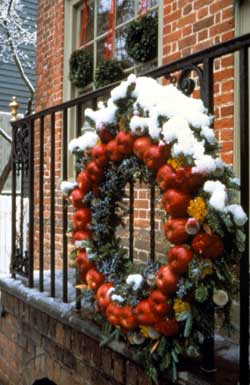
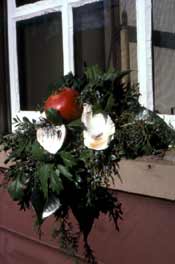
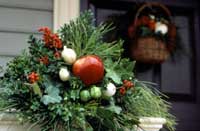
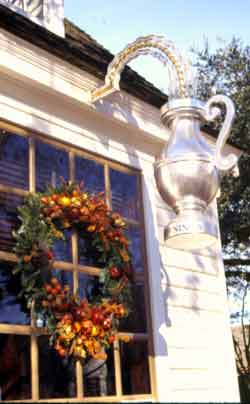
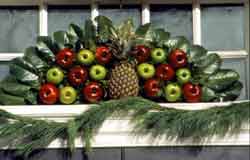
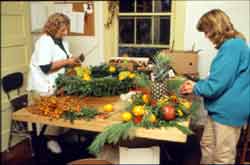
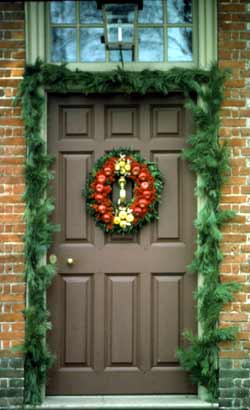
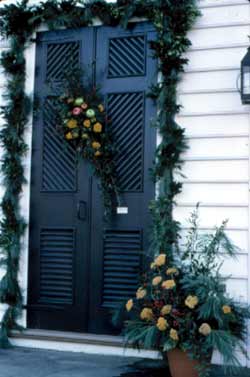
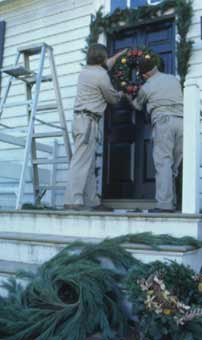
They didn't originate in Williamsburg--those fruit bedecked wreaths and swags that decorate America's front doors--nor did they begin during colonial times. No matter. Everyone from Augusta to Albuquerque calls them "Colonial Williamsburg door decorations" anyway and millions of people have visited the Historic Area during the Christmas season for the sole purpose of admiring them.
The custom of affixing fruits, vegetables, dried flowers, herbs, and other plant life to basic Christmas forms like wreaths, swags, and roping traces its roots to the early years of the twentieth century, a time when Christmas was growing in significance and the Colonial Revival was pulling decorative impulses back toward the eighteenth century. A 1926 issue of House Beautiful illustrates several fruit-laden wreaths and explains, "Of late years, besides the staple wreaths of plain greens to which we have long been accustomed, the holiday's emblems have blossomed forth,--or perhaps we should say fruited forth,--with richness of color produced by the use of either natural or artificial fruit as an embellishment. This idea was undoubtedly suggested by the gorgeous Italian carvings and terra cottas of the Renaissance. . ."
The magazine was referring to fifteenth-century Italian sculptor Luca della Robbia and his progeny, the family whose name has become synonymous with fruit and foliage swags. There is, however, another influence, one closer at hand: a sculptor with the improbable name of Grinling Gibbons who produced popular architectural wood carvings with festoons of fruit, flowers, and other bits of nature in borders and decorative motifs for English cathedrals and English royalty until his death in 1720.
The linking of fruited "della Robbia" wreaths with Christmas and front doors seems to have started during the early years of this century in America's wealthier homes. To judge by the home and garden decorating magazines of the day, Christmas greenery of any sort on doorways was rare. Only the toney publications, loaded with advertisements for grand pianos, Packards, sterling silver tea services, and seven-week cruises, show photographs of homes with holiday trimmings--and even these are few and far between. It was left to Colonial Williamsburg to popularize this sort of decoration with the country's expanding and prosperous postwar middle class.
When Colonial Williamsburg first decorated for Christmas in 1936, the greenery was confined to a few plain wreaths and some running cedar to hang about the Governor's Palace and the Raleigh Tavern. Mrs. Louise Fisher, placed in charge of flowers and Christmas decorations, drove to the Library of Congress where she turned up English and American pictorial examples from the period to use as guides. By 1939 her "della Robbia" wreaths were attracting considerable comment and the "Williamsburg Christmas look" was launched.
The contest caught on. Many took it very seriously. In 1940 the second place winner, Mrs. Bela W. Norton, thanked the judges for her award and promised to try to do better next year. Some years winners were chosen by the Garden Club, at other times by a committee of locals, by visitors' ballot, or by the Governor's wife. Blue ribbons affixed to the houses proclaimed the five to ten winners and the public became so enamored with the contest that in 1969, the "Christmas Decorations Tour" was inaugurated.
Never mind that no one in the eighteenth century would have been caught dead with real fruit tacked to his front door. Anyone hanging fresh fruit outdoors in the middle of winter to rot or be devoured by squirrels would have been thought, at best, highly eccentric by his neighbors.
The practice that was adopted and adapted by Colonial Williamsburg in the early years of the restoration spread across the country by means of continual publicity in decorating magazines. Thousands of visitors, fascinated by the imaginative decorations, strolled the streets of Williamsburg snapping pictures of their favorite creations to try back home. Visitor queries resulted in how-to books and videos, workshops, and television demonstrations, until a virtual cottage industry of instruction and materials had sprung up.
The fact that these decorations are made, not purchased, helps put some badly needed distance between ourselves and the commercialization of Christmas and must, in the end, account for a lot of their enduring appeal. Made at home of natural materials--holly berries clipped from a tree, seed pods collected from a nearby field, pine cones found on the forest floor, magnolia leaves pinched from the back yard, and oyster shells gathered at the beach last summer--the decorations suggest a time when the holidays revolved not around plastic reindeer at the mall but around the sharing of one's blessings with friends and family.
The nature of the door decorations has changed noticeably over the past sixty years. Tastes have changed, of course--the pictorial themes so popular in the fifties and sixties are no longer in evidence--but it goes further than that. Conservation concerns led to the elimination of running cedar and mountain laurel.
Authenticity concerns caused the banning of ribbon and bows, fake fruit, and any material not available to eighteenth-century residents of Williamsburg such as poinsettias, pepper berries, and eucalyptus. The gradual lengthening of the Williamsburg Christmas season from one week to four brought about a surge in the use of dried materials: peanut shells, dried flowers, dried peppers, and cotton bolls did not have to be replenished every few days like pears and lemons. "Freezing temperatures at night followed by the hot sun during the day can destroy some fruits faster than they can be replaced," explained one long-time Historic Area resident.
Other residents have begun using a "floral cage" to prolong the life of their fragile plant material such as ivy. This concealed container holds a chunk of floral foam that keeps the material wet and fresh for weeks.
Regular visitors to Colonial Williamsburg have seen quite a variety of door decorations over the years. The featured photographs were culled from thousands in the Williamsburg archives to illustrate some of these trends.
This article was originally published in the Winter 1996-97 edition of the Colonial Williamsburg Journal.
Libbey Oliver and Mary Theobald have teamed to write Williamsburg Christmas, available from the Colonial Williamsburg online catalog.
Visit our Christmas section.
